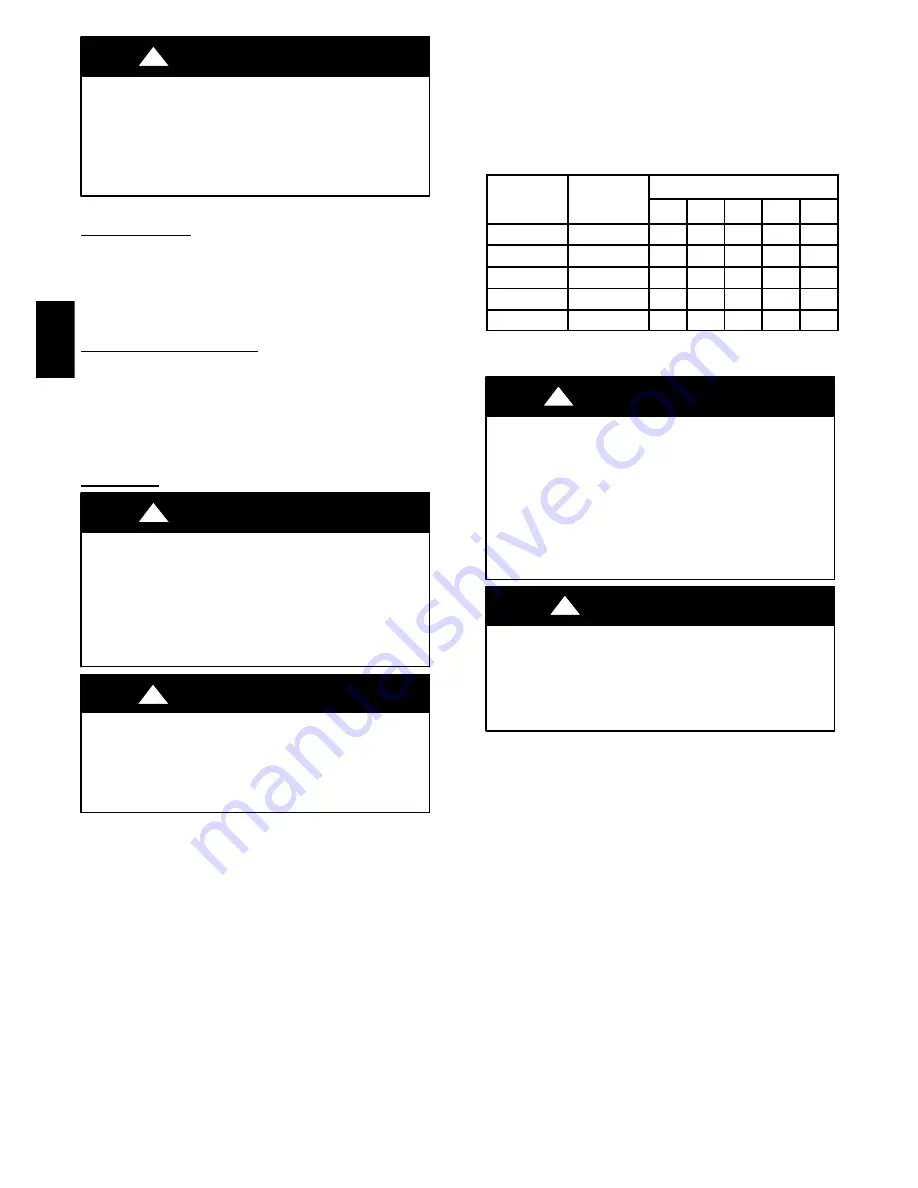
20
FIRE HAZARD
A failure to follow this warning could result in personal
injury, or death and/or property damage.
Never connect return--air ducts to the back of the
furnace. Follow instructions below.
!
WARNING
Return Air Connections
Downflow Furnaces
The return--air duct must be connected to return--air opening
(bottom inlet) as shown in Fig. 19. DO NOT cut into casing sides
(left or right). Side opening is permitted for only upflow and most
horizontal furnaces. (See Fig. 19.) Bypass humidifier connections
should be made at ductwork or coil casing sides exterior to
furnace.
Upflow and Horizontal Furnaces
The return--air duct must be connected to bottom, sides (left or
right), or a combination of bottom and side(s) of main furnace
casing as shown in Fig. 18 and 20. Bypass humidifier may be
attached into unused return air side of the furnace casing. (See
Fig. 18 and 20.)
Not all horizontal furnaces are approved for side return air
connections. (See Fig. 20.)
GAS PIPING
FIRE OR EXPLOSION HAZARD
Failure to follow this warning could result in personal
injury, death, and/or property damage.
Never purge a gas line into a combustion chamber. Never
test for gas leaks with an open flame. Use a commercially
available soap solution made specifically for the detection
of leaks to check all connections.
!
WARNING
FIRE OR EXPLOSION HAZARD
Failure to follow this warning could result in personal
injury, death, and/or property damage.
Use proper length of pipe to avoid stress on gas control
manifold and a gas leak.
!
WARNING
Gas piping must be installed in accordance with national and
local codes. Refer to current edition of NFGC in the U.S., the
NSCNGPIC in Canada.
Installations must be made in accordance with all authorities
having jurisdiction. If possible, the gas supply line should be a
separate line running directly from meter to furnace.
NOTE
: In the state of Massachusetts:
1. Gas supply connections MUST be performed by a li-
censed plumber or gas fitter.
2. When flexible connectors are used, the maximum length
shall not exceed 36 inches (915 mm).
3. When lever handle type manual equipment shutoff valves
are used, they shall be T--handle valves.
4. The use of copper tubing for gas piping is NOT approved
by the state of Massachusetts.
Refer to Table 6 for recommended gas pipe sizing. Risers must be
used to connect to furnace and to meter. Support all gas piping
with appropriate straps, hangers, etc. Use a minimum of 1 hanger
every 6 ft. Joint compound (pipe dope) should be applied
sparingly and only to male threads of joints. Pipe dope must be
resistant to the action of propane gas.
TABLE 6—MAXIMUM CAPACITY OF PIPE*
NOMINAL
IRON PIPE
SIZE (IN.)
INTERNAL
DIAMETER
(IN.)
LENGTH OF PIPE (FT.)
10
20
30
40
50
1/2
0.622
175
120
97
82
73
3/4
0.824
360
250
200
170
151
1
1.049
680
465
375
320
285
1---1/4
1.380
1400
950
770
660
580
1---1/2
1.610
2100 1460 1180
990
900
* Cubic ft. of natural gas per hr for gas pressures of 0.5 psig (14---in. wc)
or less and a pressure drop of 0.5---in. wc (based on a 0.60 specific
gravity gas). Ref: Table 12.2 ANSI Z223---2006/NFPA 54---2006.
FIRE OR EXPLOSION HAZARD
Failure to follow this warning could result in personal
injury, death, and/or property damage.
If local codes allow the use of a flexible gas appliance
connector, always use a new listed connector. Do not use a
connector which has previously served another gas
appliance. Black iron pipe shall be installed at the furnace
gas control valve and extend a minimum of 2 in. outside the
furnace.
!
WARNING
FURNACE OVERHEAT HAZARD
Failure to follow this caution may result in unit component
damage.
Connect gas pipe to gas valve using a backup wrench to
avoid damaging gas controls and burner misalignment.
CAUTION
!
An accessible manual equipment shutoff valve MUST be
installed external to furnace casing and within 6 ft. of furnace. A
1/8--in. NPT plugged tapping, accessible for test gauge
connection, MUST be installed immediately upstream of gas
supply connection to furnace and downstream of manual
equipment shutoff valve.
PG
8J
/M
















































